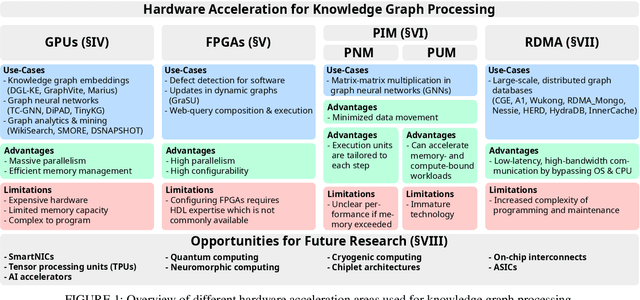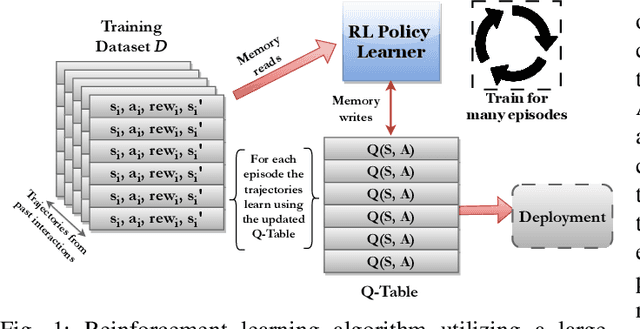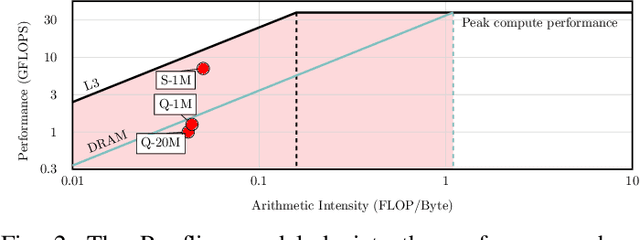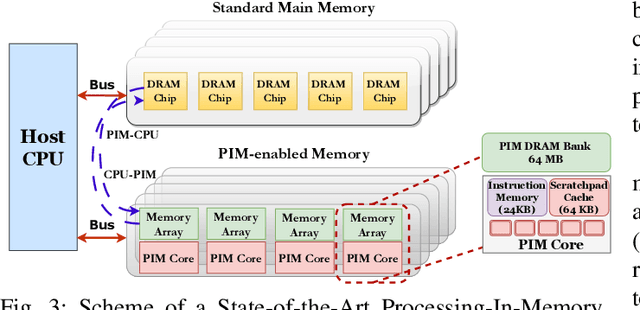Onur Mutlu
Alex
Harmonia: A Multi-Agent Reinforcement Learning Approach to Data Placement and Migration in Hybrid Storage Systems
Mar 26, 2025Abstract:Hybrid storage systems (HSS) combine multiple storage devices with diverse characteristics to achieve high performance and capacity at low cost. The performance of an HSS highly depends on the effectiveness of two key policies: (1) the data-placement policy, which determines the best-fit storage device for incoming data, and (2) the data-migration policy, which rearranges stored data across the devices to sustain high HSS performance. Prior works focus on improving only data placement or only data migration in HSS, which leads to sub-optimal HSS performance. Unfortunately, no prior work tries to optimize both policies together. Our goal is to design a holistic data-management technique for HSS that optimizes both data-placement and data-migration policies to fully exploit the potential of an HSS. We propose Harmonia, a multi-agent reinforcement learning (RL)-based data-management technique that employs two light-weight autonomous RL agents, a data-placement agent and a data-migration agent, which adapt their policies for the current workload and HSS configuration, and coordinate with each other to improve overall HSS performance. We evaluate Harmonia on a real HSS with up to four heterogeneous storage devices with diverse characteristics. Our evaluation using 17 data-intensive workloads on performance-optimized (cost-optimized) HSS with two storage devices shows that, on average, Harmonia (1) outperforms the best-performing prior approach by 49.5% (31.7%), (2) bridges the performance gap between the best-performing prior work and Oracle by 64.2% (64.3%). On an HSS with three (four) devices, Harmonia outperforms the best-performing prior work by 37.0% (42.0%). Harmonia's performance benefits come with low latency (240ns for inference) and storage overheads (206 KiB for both RL agents together). We plan to open-source Harmonia's implementation to aid future research on HSS.
PAPI: Exploiting Dynamic Parallelism in Large Language Model Decoding with a Processing-In-Memory-Enabled Computing System
Feb 21, 2025Abstract:Large language models (LLMs) are widely used for natural language understanding and text generation. An LLM model relies on a time-consuming step called LLM decoding to generate output tokens. Several prior works focus on improving the performance of LLM decoding using parallelism techniques, such as batching and speculative decoding. State-of-the-art LLM decoding has both compute-bound and memory-bound kernels. Some prior works statically identify and map these different kernels to a heterogeneous architecture consisting of both processing-in-memory (PIM) units and computation-centric accelerators. We observe that characteristics of LLM decoding kernels (e.g., whether or not a kernel is memory-bound) can change dynamically due to parameter changes to meet user and/or system demands, making (1) static kernel mapping to PIM units and computation-centric accelerators suboptimal, and (2) one-size-fits-all approach of designing PIM units inefficient due to a large degree of heterogeneity even in memory-bound kernels. In this paper, we aim to accelerate LLM decoding while considering the dynamically changing characteristics of the kernels involved. We propose PAPI (PArallel Decoding with PIM), a PIM-enabled heterogeneous architecture that exploits dynamic scheduling of compute-bound or memory-bound kernels to suitable hardware units. PAPI has two key mechanisms: (1) online kernel characterization to dynamically schedule kernels to the most suitable hardware units at runtime and (2) a PIM-enabled heterogeneous computing system that harmoniously orchestrates both computation-centric processing units and hybrid PIM units with different computing capabilities. Our experimental results on three broadly-used LLMs show that PAPI achieves 1.8$\times$ and 11.1$\times$ speedups over a state-of-the-art heterogeneous LLM accelerator and a state-of-the-art PIM-only LLM accelerator, respectively.
Hardware Acceleration for Knowledge Graph Processing: Challenges & Recent Developments
Aug 22, 2024
Abstract:Knowledge graphs (KGs) have achieved significant attention in recent years, particularly in the area of the Semantic Web as well as gaining popularity in other application domains such as data mining and search engines. Simultaneously, there has been enormous progress in the development of different types of heterogeneous hardware, impacting the way KGs are processed. The aim of this paper is to provide a systematic literature review of knowledge graph hardware acceleration. For this, we present a classification of the primary areas in knowledge graph technology that harnesses different hardware units for accelerating certain knowledge graph functionalities. We then extensively describe respective works, focusing on how KG related schemes harness modern hardware accelerators. Based on our review, we identify various research gaps and future exploratory directions that are anticipated to be of significant value both for academics and industry practitioners.
Roadmap to Neuromorphic Computing with Emerging Technologies
Jul 02, 2024



Abstract:The roadmap is organized into several thematic sections, outlining current computing challenges, discussing the neuromorphic computing approach, analyzing mature and currently utilized technologies, providing an overview of emerging technologies, addressing material challenges, exploring novel computing concepts, and finally examining the maturity level of emerging technologies while determining the next essential steps for their advancement.
SwiftRL: Towards Efficient Reinforcement Learning on Real Processing-In-Memory Systems
May 07, 2024



Abstract:Reinforcement Learning (RL) trains agents to learn optimal behavior by maximizing reward signals from experience datasets. However, RL training often faces memory limitations, leading to execution latencies and prolonged training times. To overcome this, SwiftRL explores Processing-In-Memory (PIM) architectures to accelerate RL workloads. We achieve near-linear performance scaling by implementing RL algorithms like Tabular Q-learning and SARSA on UPMEM PIM systems and optimizing for hardware. Our experiments on OpenAI GYM environments using UPMEM hardware demonstrate superior performance compared to CPU and GPU implementations.
Analysis of Distributed Optimization Algorithms on a Real Processing-In-Memory System
Apr 10, 2024



Abstract:Machine Learning (ML) training on large-scale datasets is a very expensive and time-consuming workload. Processor-centric architectures (e.g., CPU, GPU) commonly used for modern ML training workloads are limited by the data movement bottleneck, i.e., due to repeatedly accessing the training dataset. As a result, processor-centric systems suffer from performance degradation and high energy consumption. Processing-In-Memory (PIM) is a promising solution to alleviate the data movement bottleneck by placing the computation mechanisms inside or near memory. Our goal is to understand the capabilities and characteristics of popular distributed optimization algorithms on real-world PIM architectures to accelerate data-intensive ML training workloads. To this end, we 1) implement several representative centralized distributed optimization algorithms on UPMEM's real-world general-purpose PIM system, 2) rigorously evaluate these algorithms for ML training on large-scale datasets in terms of performance, accuracy, and scalability, 3) compare to conventional CPU and GPU baselines, and 4) discuss implications for future PIM hardware and the need to shift to an algorithm-hardware codesign perspective to accommodate decentralized distributed optimization algorithms. Our results demonstrate three major findings: 1) Modern general-purpose PIM architectures can be a viable alternative to state-of-the-art CPUs and GPUs for many memory-bound ML training workloads, when operations and datatypes are natively supported by PIM hardware, 2) the importance of carefully choosing the optimization algorithm that best fit PIM, and 3) contrary to popular belief, contemporary PIM architectures do not scale approximately linearly with the number of nodes for many data-intensive ML training workloads. To facilitate future research, we aim to open-source our complete codebase.
Accelerating Graph Neural Networks on Real Processing-In-Memory Systems
Feb 26, 2024



Abstract:Graph Neural Networks (GNNs) are emerging ML models to analyze graph-structure data. Graph Neural Network (GNN) execution involves both compute-intensive and memory-intensive kernels, the latter dominates the total time, being significantly bottlenecked by data movement between memory and processors. Processing-In-Memory (PIM) systems can alleviate this data movement bottleneck by placing simple processors near or inside to memory arrays. In this work, we introduce PyGim, an efficient ML framework that accelerates GNNs on real PIM systems. We propose intelligent parallelization techniques for memory-intensive kernels of GNNs tailored for real PIM systems, and develop handy Python API for them. We provide hybrid GNN execution, in which the compute-intensive and memory-intensive kernels are executed in processor-centric and memory-centric computing systems, respectively, to match their algorithmic nature. We extensively evaluate PyGim on a real-world PIM system with 1992 PIM cores using emerging GNN models, and demonstrate that it outperforms its state-of-the-art CPU counterpart on Intel Xeon by on average 3.04x, and achieves higher resource utilization than CPU and GPU systems. Our work provides useful recommendations for software, system and hardware designers. PyGim will be open-sourced to enable the widespread use of PIM systems in GNNs.
Topologies of Reasoning: Demystifying Chains, Trees, and Graphs of Thoughts
Jan 25, 2024Abstract:The field of natural language processing (NLP) has witnessed significant progress in recent years, with a notable focus on improving large language models' (LLM) performance through innovative prompting techniques. Among these, prompt engineering coupled with structures has emerged as a promising paradigm, with designs such as Chain-of-Thought, Tree of Thoughts, or Graph of Thoughts, in which the overall LLM reasoning is guided by a structure such as a graph. As illustrated with numerous examples, this paradigm significantly enhances the LLM's capability to solve numerous tasks, ranging from logical or mathematical reasoning to planning or creative writing. To facilitate the understanding of this growing field and pave the way for future developments, we devise a general blueprint for effective and efficient LLM reasoning schemes. For this, we conduct an in-depth analysis of the prompt execution pipeline, clarifying and clearly defining different concepts. We then build the first taxonomy of structure-enhanced LLM reasoning schemes. We focus on identifying fundamental classes of harnessed structures, and we analyze the representations of these structures, algorithms executed with these structures, and many others. We refer to these structures as reasoning topologies, because their representation becomes to a degree spatial, as they are contained within the LLM context. Our study compares existing prompting schemes using the proposed taxonomy, discussing how certain design choices lead to different patterns in performance and cost. We also outline theoretical underpinnings, relationships between prompting and others parts of the LLM ecosystem such as knowledge bases, and the associated research challenges. Our work will help to advance future prompt engineering techniques.
TransPimLib: A Library for Efficient Transcendental Functions on Processing-in-Memory Systems
Apr 23, 2023



Abstract:Processing-in-memory (PIM) promises to alleviate the data movement bottleneck in modern computing systems. However, current real-world PIM systems have the inherent disadvantage that their hardware is more constrained than in conventional processors (CPU, GPU), due to the difficulty and cost of building processing elements near or inside the memory. As a result, general-purpose PIM architectures support fairly limited instruction sets and struggle to execute complex operations such as transcendental functions and other hard-to-calculate operations (e.g., square root). These operations are particularly important for some modern workloads, e.g., activation functions in machine learning applications. In order to provide support for transcendental (and other hard-to-calculate) functions in general-purpose PIM systems, we present \emph{TransPimLib}, a library that provides CORDIC-based and LUT-based methods for trigonometric functions, hyperbolic functions, exponentiation, logarithm, square root, etc. We develop an implementation of TransPimLib for the UPMEM PIM architecture and perform a thorough evaluation of TransPimLib's methods in terms of performance and accuracy, using microbenchmarks and three full workloads (Blackscholes, Sigmoid, Softmax). We open-source all our code and datasets at~\url{https://github.com/CMU-SAFARI/transpimlib}.
RedBit: An End-to-End Flexible Framework for Evaluating the Accuracy of Quantized CNNs
Jan 15, 2023Abstract:In recent years, Convolutional Neural Networks (CNNs) have become the standard class of deep neural network for image processing, classification and segmentation tasks. However, the large strides in accuracy obtained by CNNs have been derived from increasing the complexity of network topologies, which incurs sizeable performance and energy penalties in the training and inference of CNNs. Many recent works have validated the effectiveness of parameter quantization, which consists in reducing the bit width of the network's parameters, to enable the attainment of considerable performance and energy efficiency gains without significantly compromising accuracy. However, it is difficult to compare the relative effectiveness of different quantization methods. To address this problem, we introduce RedBit, an open-source framework that provides a transparent, extensible and easy-to-use interface to evaluate the effectiveness of different algorithms and parameter configurations on network accuracy. We use RedBit to perform a comprehensive survey of five state-of-the-art quantization methods applied to the MNIST, CIFAR-10 and ImageNet datasets. We evaluate a total of 2300 individual bit width combinations, independently tuning the width of the network's weight and input activation parameters, from 32 bits down to 1 bit (e.g., 8/8, 2/2, 1/32, 1/1, for weights/activations). Upwards of 20000 hours of computing time in a pool of state-of-the-art GPUs were used to generate all the results in this paper. For 1-bit quantization, the accuracy losses for the MNIST, CIFAR-10 and ImageNet datasets range between [0.26%, 0.79%], [9.74%, 32.96%] and [10.86%, 47.36%] top-1, respectively. We actively encourage the reader to download the source code and experiment with RedBit, and to submit their own observed results to our public repository, available at https://github.com/IT-Coimbra/RedBit.
 Add to Chrome
Add to Chrome Add to Firefox
Add to Firefox Add to Edge
Add to Edge